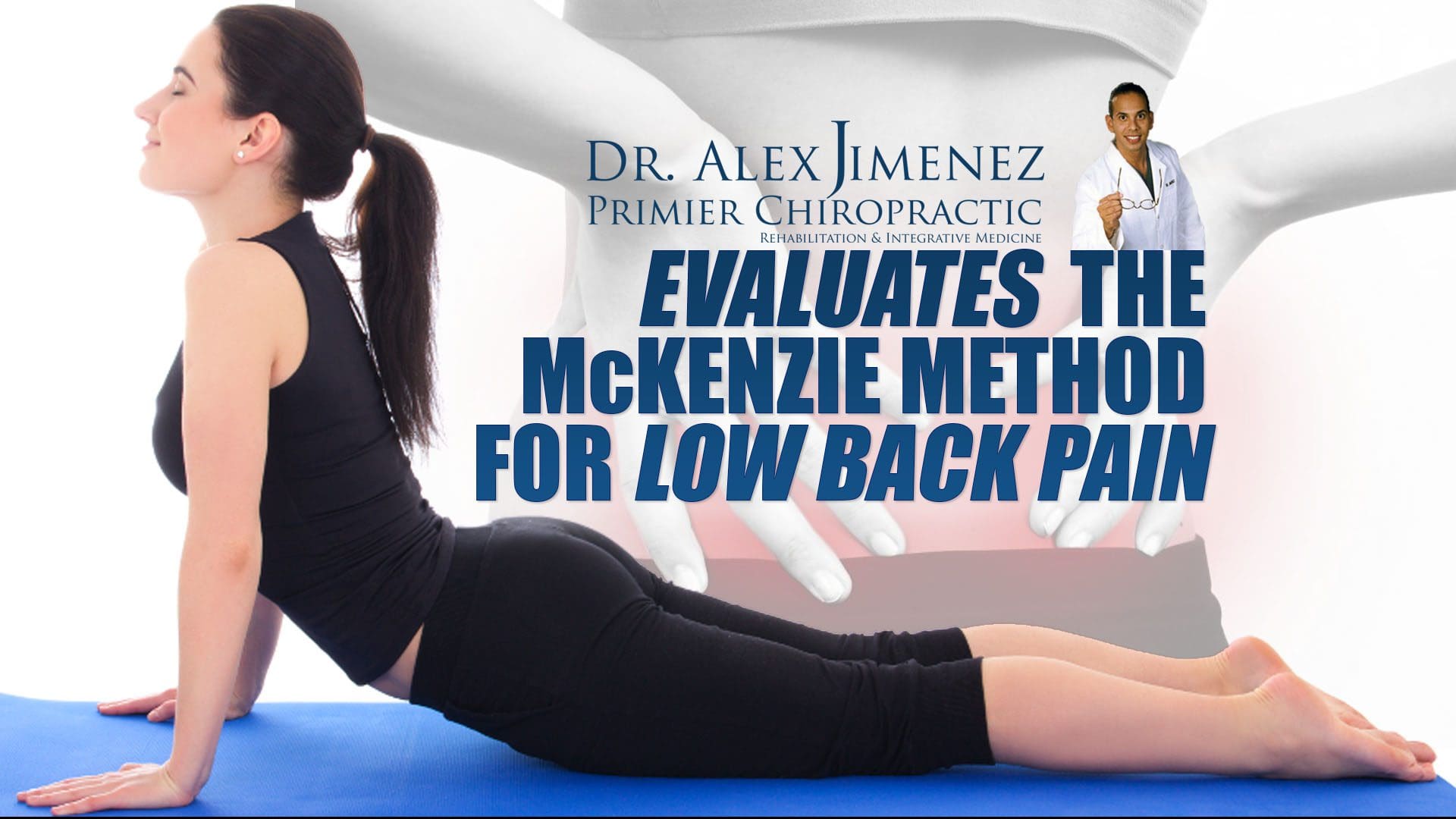Acknowledging statistical data, low back pain can be the result of a variety of injuries and/or conditions affecting the lumbar spine and its surrounding structures. Most cases of low back pain, however, will resolve on their own in a matter of weeks. But when symptoms of low back pain become chronic, its essential for the affected individual to seek treatment from the most appropriate healthcare professional. The McKenzie method has been used by many healthcare specialists in the treatment of low back pain and its effects have been recorded widely throughout various research studies. The following two articles are being presented to evaluate the McKenzie method in the treatment of LBP in comparison to other types of treatment options.
Table of Contents
Efficacy of the McKenzie Method in Patients With Chronic Nonspecific Low Back Pain: A Protocol of Randomized Placebo-Controlled Trial
Presented Abstract
- Background: The McKenzie method is widely used as an active intervention in the treatment of patients with nonspecific low back pain. Although the McKenzie method has been compared with several other interventions, it is not yet known whether this method is superior to placebo in patients with chronic low back pain.
- Objective: The purpose of this trial is to assess the efficacy of the McKenzie method in patients with chronic nonspecific low back pain.
- Design: An assessor-blinded, 2-arm, randomized placebo-controlled trial will be conducted.
- Setting: This study will be conducted in physical therapy clinics in São Paulo, Brazil.
- Participants: The participants will be 148 patients seeking care for chronic nonspecific low back pain.
- Intervention: Participants will be randomly allocated to 1 of 2 treatment groups: (1) McKenzie method or (2) placebo therapy (detuned ultrasound and shortwave therapy). Each group will receive 10 sessions of 30 minutes each (2 sessions per week over 5 weeks).
- Measurements: The clinical outcomes will be obtained at the completion of treatment (5 weeks) and at 3, 6, and 12 months after randomization. The primary outcomes will be pain intensity (measured with the Pain Numerical Rating Scale) and disability (measured with the Roland-Morris Disability Questionnaire) at the completion of treatment. The secondary outcomes will be pain intensity; disability and function; kinesiophobia and global perceived effect at 3, 6, and 12 months after randomization; and kinesiophobia and global perceived effect at completion of treatment. The data will be collected by a blinded assessor.
- Limitations: Therapists will not be blinded.
- Conclusions: This will be the first trial to compare the McKenzie method with placebo therapy in patients with chronic nonspecific low back pain. The results of this study will contribute to better management of this population.
- Subject: Therapeutic Exercise, Injuries and Conditions: Low Back, Protocols
- Issue Section: Protocol
Low back pain is a major health condition associated with a high rate of absenteeism from work and a more frequent use of health services and work leave entitlements.[1] Low back pain recently was rated by the Global Burden of Disease Study as one of the 7 health conditions that most affect the world’s population,[2] and it is considered a debilitating health condition that affects the population for the greatest number of years over a lifetime.[2] The point prevalence of low back pain in the general population is reported to be up to 18%, increasing to 31% in the last 30 days, 38% in the last 12 months, and 39% at any point in life.[3] Low back pain also is associated with high treatment costs.[4] It is estimated that in European countries, the direct and indirect costs vary from €2 to €4 billion a year.[4] The prognosis of low back pain is directly related to the duration of the symptoms.[5,6] Patients with chronic low back pain have a less favorable prognosis compared with patients with acute low back pain[5,7] and are responsible for most of the costs for management of back pain, generating the need for research aimed at finding better treatments for these patients.
There is a great variety of interventions for the treatment of patients with chronic low back pain, including the McKenzie method developed by Robin McKenzie in New Zealand in 1981.[8] The McKenzie method (also known as Mechanical Diagnosis and Therapy [MDT]) is an active therapy that involves repeated movements or sustained positions and has an educational component with the purpose of minimizing pain and disability and improving spinal mobility.[8] The McKenzie method involves the assessment of symptomatic and mechanical responses to repeated movements and sustained positions. Patients’ responses to this assessment are used to classify them into subgroups or syndromes called derangement, dysfunction, and posture.[8–10] Classification according to one of these groups guides the treatment principles.

Derangement syndrome is the largest group and characterized by patients who demonstrate centralization (transition of pain from distal to proximal) or disappearance of pain[11] with repeated movement testing in one direction. These patients are treated with repeated movements or sustained positions that could reduce pain. Patients classified as having dysfunction syndrome are characterized by pain that occurs only at the end of the range of motion of only one movement.[8] The pain does not change or centralize with repeated movement testing. The treatment principle for patients with dysfunction is repeated movements in the direction that generated the pain. Finally, patients classified as having postural syndrome experience intermittent pain only during sustained positioning at the end of the range of motion (eg, sustained slumped sitting).[8] The treatment principle for this syndrome consists of posture correction.[11]
The McKenzie method also includes a strong educational component based on the books titled The Lumbar Spine: Mechanical Diagnosis & Therapy: Volume Two[11] and Treat Your Own Back.[12] This method, unlike other therapeutic methods, aims to make the patients as independent of the therapist as possible and thus capable of controlling their pain through postural care and the practice of specific exercises for their problem.[11] It encourages patients to move the spine in the direction that is not harmful to their problem, thus avoiding movement restriction due to kinesiophobia or pain.[11]
Two previous systematic reviews have analyzed the effects of the McKenzie method[9,10] in patients with acute, subacute, and chronic low back pain. The review by Clare et al[9] demonstrated that the McKenzie method showed better results in short-term pain relief and improvement of disability compared with active interventions such as physical exercise. The review by Machado et al[10] showed that the McKenzie method reduced pain and disability in the short term when compared with passive therapy for acute low back pain. For chronic low back pain, the 2 reviews were unable to draw conclusions about the effectiveness of the McKenzie method due to the lack of appropriate trials. The randomized controlled trials that have investigated the McKenzie method in patients with chronic low back pain[13–17] compared the method with other interventions such as resistance training,[17] the Williams method,[14] unsupervised exercises,[16] trunk strengthening,[15] and stabilization exercises.[13] Better results in reducing pain intensity were obtained with the McKenzie method compared with resistance training,[17] the Williams method,[14] and supervised exercise.[16] However, the methodological quality of these trials[13–17] is suboptimal.
It is known from the literature that the McKenzie method yields beneficial results when compared with some clinical interventions in patients with chronic low back pain; however, to date, no studies have compared the McKenzie method against a placebo treatment in order to identify its actual efficacy. Clare et al[9] highlighted the need to compare the McKenzie method with placebo therapy and to study the effects of the method in the long term. In other words, it is not known whether the positive effects of the McKenzie method are due to its real efficacy or simply to a placebo effect.
The objective of this study will be to assess the efficacy of the McKenzie method in patients with chronic nonspecific low back pain using a high-quality randomized placebo-controlled trial.
Method
Study Design
This will be an assessor-blinded, 2-arm, randomized placebo-controlled trial.
Study Setting
This study will be conducted in physical therapy clinics in São Paulo, Brazil.
Eligibility Criteria
The study will include patients seeking care for chronic nonspecific low back pain (defined as pain or discomfort between the costal margins and the inferior gluteal folds, with or without referred symptoms in the lower limbs, for at least 3 months[18]), with a pain intensity of at least 3 points as measured with the 0- to 10-point Pain Numerical Rating Scale, aged between 18 and 80 years, and able to read Portuguese. Patients will be excluded if they have any contraindication to physical exercise[19] or ultrasound or shortwave therapy, evidence of nerve root compromise (ie, one or more motor, reflex, or sensation deficits), serious spinal pathology (eg, fracture, tumor, inflammatory and infectious diseases), serious cardiovascular and metabolic diseases, previous back surgery, or pregnancy.
Procedure
First, the patients will be interviewed by the study’s blinded assessor, who will determine eligibility. Eligible patients will be informed about the objectives of the study and asked to sign a consent form. Next, the patient’s sociodemographic data and medical history will be recorded. The assessor will then collect the data related to the study outcomes at the baseline assessment, after completion of 5 weeks of treatment, and 3, 6, and 12 months after randomization. With the exception of baseline measurements, all other assessments will be collected over the telephone. All data entry will be coded, entered into an Excel (Microsoft Corporation, Redmond, Washington) spreadsheet, and double-checked prior to the analysis.
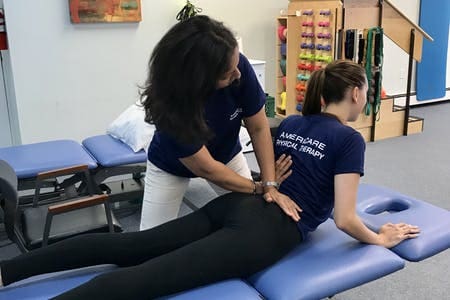
Outcome Measures
The clinical outcomes will be measured at the baseline assessment, after treatment, and 3, 6, and 12 months after random allocation. The primary outcomes will be pain intensity (measured with the Pain Numerical Rating Scale)[20] and disability (measured with the Roland-Morris Disability Questionnaire)[21,22] after completion of 5 weeks of treatment. The secondary outcomes will be pain intensity and disability 3, 6, and 12 months after randomization and disability and function (measured by the Patient-Specific Functional Scale),[20] kinesiophobia (measured with the Tampa Scale of Kinesiophobia),[23] and global perceived effect (measured with the Global Perceived Effect Scale)[20] after treatment and 3, 6, and 12 months after randomization. On the day of the baseline assessment, each patient’s expectancy for improvement also will be assessed using the Expectancy of Improvement Numerical Scale,[24] followed by assessment using the McKenzie method.[8] Patients may experience an exacerbation of symptoms after the baseline assessment due to the MDT physical examination. All measurements were previously cross-culturally adapted into Portuguese and clinimetrically tested and are described below.
Pain Numerical Rating Scale
The Pain Numerical Rating Scale is a scale that assesses the levels of pain intensity perceived by the patient using an 11-point scale (varying from 0 to 10), in which 0 represents “no pain” and 10 represents the “worst possible pain.”[20] The participants will be instructed to select the average of pain intensity based on the last 7 days.
Roland-Morris Disability Questionnaire
This questionnaire consists of 24 items that describe daily activities that patients have difficulty performing due to low back pain.[21,22] The higher the number of affirmative answers, the higher the level of disability associated with low back pain.[21,22] The participants will be instructed to complete the questionnaire based on the last 24 hours.
Patient-Specific Functional Scale
The Patient-Specific Functional Scale is a global scale; therefore, it can be used for any part of the body.[25,26] The patients will be asked to identify up to 3 activities that they feel unable to perform or that they have difficulty performing due to their low back pain.[25,26] Measurement will be taken using Likert-type, 11-point scales for each activity, with higher average scores (ranging from 0 to 10 points) representing better ability to perform the tasks.[25,26] We will calculate the average of these activities based on the last 24 hours, with a final score ranging from 0 to 10.
Global Perceived Effect Scale
The Global Perceived Effect Scale is a Likert-type, 11-point scale (ranging from −5 to +5) that compares the patient’s current condition with his or her condition at the onset of symptoms.[20] Positive scores apply to patients who are better and negative scores apply to patients who are worse in relation to the onset of symptoms.[20]
Tampa Scale of Kinesiophobia
This scale assesses the level of kinesiophobia (fear of moving) by means of 17 questions that deal with pain and intensity of symptoms.[23] The scores from each item vary from 1 to 4 points (eg, 1 point for “strongly disagree,” 2 points for “partially disagree,” 3 points for “agree,” and 4 points for “strongly agree”).[23] For the total score, it is necessary to invert the scores of questions 4, 8, 12, and 16.[23] The final score can vary from 17 to 68 points, with higher scores representing a higher degree of kinesiophobia.[23]
Expectancy of Improvement Numerical Scale
This scale assesses the patient’s expectancy for improvement after treatment in relationship to a specific treatment.[24] It consists of an 11-point scale varying from 0 to 10, in which 0 represents “no expectancy for improvement” and 10 represents “expectancy for the greatest possible improvement.”[24] This scale will be administered only on the first day of assessment (baseline) before the randomization. The reason for including this scale is to analyze whether the expectation of improvement will influence the outcomes.
Random Allocation
Before the treatment begins, the patients will be randomly allocated to their respective intervention groups. The random allocation sequence will be implemented by one of the researchers not involved with recruiting and assessing the patients and will be generated on Microsoft Excel 2010 software. This random allocation sequence will be inserted into sequentially numbered, opaque, sealed envelopes (to ensure that allocation is concealed from the assessor). The envelopes will be opened by the physical therapist who will treat the patients.
Blinding
Given the nature of the study, it is not possible to blind the therapists to the conditions of treatment; however, the assessor and the patients will be blinded to the treatment groups. At the end of the study, the assessor will be asked whether the patients were allocated to the real treatment group or to the placebo group in order to measure assessor blinding. A visual representation of the study design is presented in the Figure.
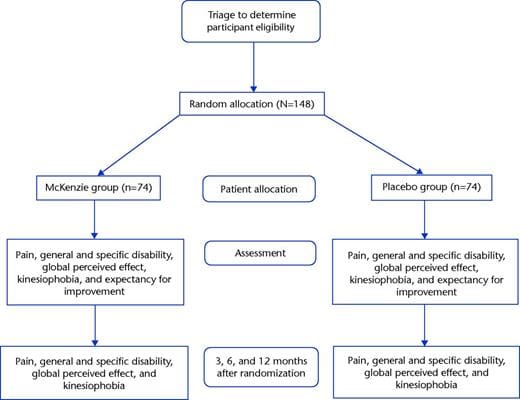
Interventions
The participants will be allocated to groups receiving 1 of 2 interventions: (1) placebo therapy or (2) MDT. Participants in each group will receive 10 sessions of 30 minutes each (2 sessions per week over 5 weeks). The studies on the McKenzie method do not have a standard number of sessions given that some studies propose low doses of treatment,[16,17,27] and others recommend higher doses.[13,15]
For ethical reasons, on the first day of treatment, patients from both groups will receive an information booklet called The Back Book,[28] based on the same recommendations as the existing guidelines.[29,30] This booklet will be translated into Portuguese so that it can be completely understood by the study’s participants, who will receive additional explanations regarding the content of the booklet, if needed. Patients will be asked in each session if they have felt any different symptom. The chief investigator of the study will periodically audit the interventions.
Placebo Group
The patients allocated to the placebo group will be treated with detuned pulsed ultrasound for 5 minutes and detuned shortwave diathermy in pulsed mode for 25 minutes. The devices will be used with the internal cables disconnected to obtain the placebo effect; however, it will be possible to handle them and adjust doses and alarms as if they were connected to simulate the pragmatism of clinical practice as well as to increase credibility of use of these devices on the patients. This technique has been used successfully in previous trials with patients with low back pain.[31–35]
McKenzie Group
The patients of the McKenzie group will be treated according to the principles of the McKenzie method,[8] and the choice of therapeutic intervention will be guided by the physical examination findings and classification. Patients also will receive written instructions from the Treat Your Own Back[12] book and will be asked to perform home exercises based on the principles of McKenzie method.[11] The descriptions of the exercises that will be prescribed in this study are published elsewhere.[27] Adherence to home exercises will be monitored by means of a daily log that the patient will fill in at home and bring to the therapist at each subsequent session.

Statistical Methods
Sample Size Calculation
The study was designed to detect a difference of 1 point in pain intensity measured with the Pain Numerical Rating Scale[20 ](estimate for standard deviation=1.84 points)[31] and a difference of 4 points in disability associated with low back pain measured with the Roland-Morris Disability Questionnaire[21,22] (estimate for standard deviation=4.9 points).[31] The following specifications were considered: statistical power of 80%, alpha level of 5%, and follow-up loss of 15%. Therefore, the study will require a sample of 74 patients per group (148 in total).
Analysis of the Effects of Treatment
The statistical analysis of our study will follow intention-to-treat principles.[36] The normality of the data will be tested by visual inspection of histograms, and the characterization of the participants will be calculated using descriptive statistical tests. The between-group differences (effects of treatment) and their respective 95% confidence intervals will be calculated by constructing mixed linear models[37] using interaction terms of treatment groups versus time. We will conduct a secondary exploratory analysis to assess whether patients classified as having derangement syndrome have a better response to the McKenzie method (compared with placebo) than those with other classifications. For this assessment, we will use a 3-way interaction for group, time, and classification. For all of these analyses, we will use the IBM SPSS software package, version 19 (IBM Corp, Armonk, New York).
Ethics
This study was approved by the Research Ethics Committee of the Universidade Cidade de São Paulo (#480.754) and prospectively registered at ClinicalTrials.gov (NCT02123394). Any protocol modifications will be reported to the Research Ethics Committee as well as to the trial registry.

Dr. Alex Jimenez’s Insight
Low back pain is one of the most common reasons people seek immediate medical attention for every year. Although many healthcare professionals are qualified and experienced in the diagnosis of the source of the patient’s low back pain, finding the right healthcare specialist who can provide the proper treatment for the individual’s LBP can be the real challenge. A variety of treatments can be used to treat low back pain, however, a wide array of healthcare professionals have started utilizing the McKenzie method in the treatment of patients with nonspecific low back pain. The purpose of the following article is to evaluate the effectiveness of the McKenzie method for low back pain, carefully analyzing the data of the research study.
Discussion
Potential Impact and Significance of the Study
The existing randomized controlled trials investigating the McKenzie method in patients with chronic low back pain have all used an alternative intervention as the comparison group.[14–17] To date, no study has compared the McKenzie method with a placebo treatment in patients with low back pain in order to identify its real efficacy, which is an important gap in the literature.[9] Interpretation of the previous comparative effectiveness studies is limited by the lack of knowledge of the efficacy of the McKenzie method for people with chronic low back pain. This study will be the first to compare McKenzie method with placebo therapy in patients with chronic nonspecific low back pain. A proper comparison against a placebo group will provide more unbiased estimates of the effects of this intervention. This type of comparison has already been done in trials aiming to assess the efficacy of motor control exercises for patients with chronic low back pain,[31] spinal manipulative therapy and diclofenac for patients with acute low back pain,[38] and exercise and advice for patients with subacute low back pain.[39]
Contribution to the Physical Therapy Profession and for Patients
The McKenzie method is one of the few methods used in physical therapy that advocates for the independence of patients.[8,12] This method also provides patients with tools to promote their autonomy in managing the current pain and even future recurrences.[12] We expect that patients treated with the McKenzie method will benefit more than the patients treated with the placebo treatment. If this hypothesis is confirmed in our study, the results will contribute to better clinical decision making of physical therapists. Moreover, the approach has the potential to reduce the burden associated with the recurrent nature of low back pain if patients can better self-manage future episodes.
Strengths and Weaknesses of the Study
This trial contemplates a substantial number of patients to minimize bias, and it was prospectively registered. We will use true randomization, concealed allocation, blinded assessment, and an intention-to-treat analysis. The treatments will be conducted by 2 therapists who were extensively trained to perform the interventions. We will monitor the home exercise program. Unfortunately, due to the interventions, we will not be able to blind the therapists to the treatment allocation. It is known from the literature that the McKenzie method yields beneficial results when compared with some clinical interventions in patients with chronic low back pain.[14–17] To date, however, no studies have compared the McKenzie method with a placebo treatment in order to identify its actual efficacy.
Future Research
The intention of this study group is to submit the results of this study to a top-level, international peer-reviewed journal. These published results may provide a basis for future trials that investigate the effectiveness of the McKenzie method when delivered at different doses (different numbers of sets, repetitions, and sessions), which is still unclear in the literature. Our secondary exploratory analysis aims to assess whether patients classified as having derangement syndrome have a better response to the McKenzie method (compared with placebo treatment) than those with other classifications. This assessment will contribute to a better understanding of possible subgroups of patients with chronic low back pain who respond best to specific interventions. This is an important issue, as exploring subgroups is currently considered the most important research priority in the field of low back pain.[40]
This study was fully funded by São Paulo Research Foundation (FAPESP) (grant number 2013/20075-5). Ms Garcia is funded by a scholarship from the Coordination for the Improvement of Higher Education Personnel/Brazilian Government (CAPES/Brazil).
The study was prospectively registered at ClinicalTrials.gov (trial registration: NCT02123394).
Predicting a Clinically Important Outcome in Patients with Low Back Pain Following McKenzie Therapy or Spinal Manipulation: A Stratified Analysis in a Randomized Controlled Trial
Presented Abstract
- Background: Reports vary considerably concerning characteristics of patients who will respond to mobilizing exercises or manipulation. The objective of this prospective cohort study was to identify characteristics of patients with a changeable lumbar condition, i.e. presenting with centralization or peripheralization, that were likely to benefit the most from either the McKenzie method or spinal manipulation.
- Methods: 350 patients with chronic low back pain were randomized to either the McKenzie method or manipulation. The possible effect modifiers were age, severity of leg pain, pain-distribution, nerve root involvement, duration of symptoms, and centralization of symptoms. The primary outcome was the number of patients reporting success at two months follow-up. The values of the dichotomized predictors were tested according to the prespecified analysis plan.
- Results: No predictors were found to produce a statistically significant interaction effect. The McKenzie method was superior to manipulation across all subgroups, thus the probability of success was consistently in favor of this treatment independent of predictor observed. When the two strongest predictors, nerve root involvement and peripheralization, were combined, the chance of success was relative risk 10.5 (95% CI 0.71-155.43) for the McKenzie method and 1.23 (95% CI 1.03-1.46) for manipulation (P = 0.11 for interaction effect).
- Conclusions: We did not find any baseline variables which were statistically significant effect modifiers in predicting different response to either McKenzie treatment or spinal manipulation when compared to each other. However, we did identify nerve root involvement and peripheralization to produce differences in response to McKenzie treatment compared to manipulation that appear to be clinically important. These findings need testing in larger studies.
- Trial registration: Clinicaltrials.gov: NCT00939107
- Electronic supplementary material: The online version of this article (doi:10.1186/s12891-015-0526-1) contains supplementary material, which is available to authorized users.
- Keywords: Low back pain, McKenzie, Spinal manipulation, Predictive value, Effect modification
Background
The most recent published guidelines for the treatment of patients with persistent non-specific low back pain (NSLBP) recommend a program focusing on self-management after initial advice and information. These patients should also be offered structured exercises tailored to the individual patient and other modalities such as spinal manipulation [1,2].
Previous studies have compared the effect of the McKenzie-method, also known as Mechanical Diagnosis and Therapy (MDT), with that of spinal manipulation (SM) in heterogeneous populations of patients with acute and subacute NSLBP and found no difference in outcome [3,4].

Recently, the need for studies testing the effect of treatment strategies for subgroups of patients with NSLBP in primary care has been emphasized in consensus-papers [5,6] as well as the current European guidelines [7], based on the hypothesis that subgroup analyses, preferably complying with the recommendations of “Prognostic Factor Research”[8], will improve decision making towards the most effective management strategies. Although initial data show promising results, there is presently insufficient evidence to recommend specific methods of subgrouping in primary care [1,9].
Three randomized studies, comprising patients with predominantly acute or subacute low back pain (LBP), have tested the effects of MDT versus SM in a subgroup of patients that presented with centralization of symptoms or directional preference (favorable response to end range motions) during physical examination [10-12]. The conclusions drawn from these studies were not in concurrence and the usefulness was limited by a low methodological quality.
Our recent randomized study, comprising patients with predominantly chronic LBP (CLBP), found a marginally better overall effect of MDT versus SM in an equivalent group [13]. In order to pursue the idea of subgrouping further, it was part of the study plan to explore predictors based on patient characteristics that could assist the clinician in targeting the most favorable treatment to the individual patient.
The objective of this study was to identify subgroups of patients with predominantly CLBP, presenting with centralization or peripheralization, which were likely to benefit from either MDT or SM two months after the completion of treatment.
Methods
Data Collection
The present study is a secondary analysis of a previously published randomized controlled trial [13]. We recruited 350 patients from September 2003 through May 2007 at an outpatient back care centre in Copenhagen, Denmark.
Patients
Patients were referred from primary care physicians for treatment of persistent LBP. Eligible patients were between 18 and 60 years of age, suffering from LBP with or without leg pain for a period of more than 6 weeks, able to speak and understand the Danish language, and fulfilled the clinical criteria for centralization or peripheralization of symptoms during initial screening. Centralization was defined as the abolition of symptoms in the most distal body region (such as the foot, lower leg, upper leg, buttocks, or lateral low back) and peripheralization was defined as the production of symptoms in a more distal body region. These findings have previously been found to have acceptable degree of inter-tester reliability (Kappa value 0.64) [14]. The initial screening was performed prior to randomization by a physical therapist with a diploma in the MDT examination system. Patients were excluded if they were free of symptoms at the day of inclusion, demonstrated positive non-organic signs [15], or if serious pathology, i.e. severe nerve root involvement (disabling back or leg pain in combination with progressive disturbances in sensibility, muscle strength, or reflexes), osteoporosis, severe spondylolisthesis, fracture, inflammatory arthritis, cancer, or referred pain from the viscera, was suspected based on physical examination and/or magnetic resonance imaging. Other exclusion criteria were application for disability pension, pending litigation, pregnancy, co-morbidity, recent back surgery, language problems, or problems with communication including abuse of drugs or alcohol.
The trial population had predominantly CLBP lasting on average 95 weeks (SD 207), mean age was 37 years (SD10), mean level of back and leg pain was 30 (SD 11.9) on a Numeric Rating Scale ranging from 0 to 60, and mean level of disability was 13 (SD 4.8) on Roland Morris Disability Questionnaire (0-23). Our method of pain measurement reflects that back pain is often a fluctuating condition where pain location and severity might vary on a daily basis. Therefore, a validated comprehensive pain questionnaire [16] was used in order to guarantee that all aspects of back and leg pain intensity were recorded. The scales are outlined in the legend to Table 1.
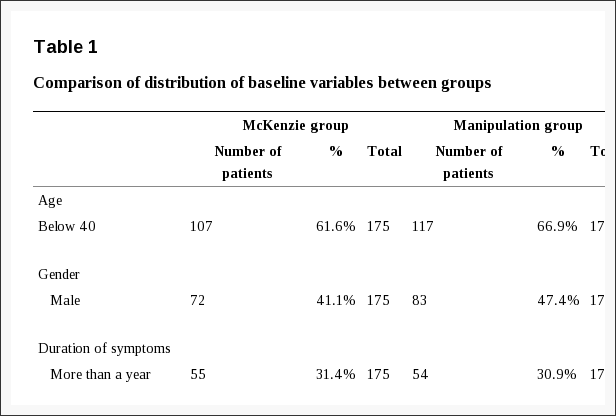
After baseline measures were obtained, randomisation was carried out by a computer-generated list of random numbers in blocks of ten using sealed opaque envelopes.
Ethics
Ethical approval of the study was granted by Copenhagen Research Ethics Committee, file no 01-057/03. All patients received written information about the study and gave their written consent prior to participation.
Treatments
The practitioners performing the treatments had no knowledge of the results of the initial screening. The treatment programs were designed to reflect daily practice as much as possible. Detailed information on these programs have been published earlier [13].
The MDT treatment was planned individually following the therapist’s pre-treatment physical assessment. Specific manual vertebral mobilization techniques including high velocity thrust were not allowed. An educational booklet describing self care [17] or a “lumbar roll” for correction of the seated position was sometimes provided to the patient at the discretion of the therapist. In the SM treatment, high velocity thrust was used in combination with other types of manual techniques. The choice of combination of techniques was at the discretion of the chiropractor. General mobilizing exercises, i.e. self-manipulation, alternating lumbar flexion/extension movements, and stretching, were allowed but not specific exercises in the directional preference. An inclined wedged pillow for correction of the seated position was available to the patients if the chiropractor believed this to be indicated.
In both treatment groups, patients were informed thoroughly of the results of the physical assessment, the benign course of back pain, and the importance of remaining physically active. Guidance on proper back care was also given. In addition, all patients were provided with a Danish version of “The Back Book” which previously has been shown to have beneficial effect on patients’ beliefs about back pain [18]. A maximum of 15 treatments for a period of 12 weeks were given. If considered necessary by the treating clinician, patients were educated in an individual program of self-administered mobilizing, stretching, stabilizing, and/or strengthening exercises at the end of the treatment period. Treatments were performed by clinicians with several years of experience. Patients were instructed to continue their individual exercises at home or at a gym for a minimum of two months after completion of the treatment at the back center. Because the patients suffered predominantly from CLBP we expected this period of self administered exercises to be necessary for the patients to experience the full effect of the intervention. Patients were encouraged not to seek any other kind of treatment during this two months period of self-administered exercises.
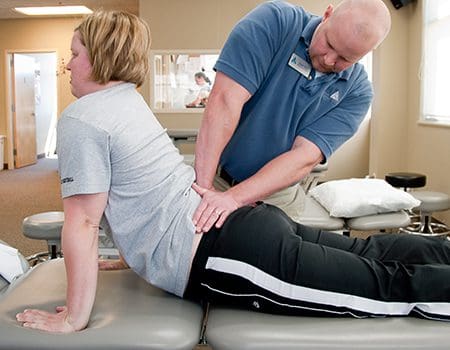
Outcome Measures
The primary outcome was the proportion of patients reporting success at follow-up two months after end of treatment. Treatment success was defined as a reduction of at least 5 points or a final score below 5 points on the 23-item modified Roland Morris Disability Questionnaire (RMDQ) [19]. A validated Danish version of RMDQ was used [20]. The definition of treatment success was based on the recommendations by others [21,22]. A sensitivity analysis using 30% relative improvement on RMDQ as definition of success was also performed. In accordance with the protocol [13], we considered a relative between-group difference of 15% in the number of patients with successful outcome to be minimal clinically important in our analysis of interaction.
Prespecified Predictor Variables
In order to reduce the likelihood of spurious findings [23], we restricted the number of candidate effect modifiers in the dataset to six. To increase the validity of our findings, a directional hypothesis was established for each variable according to the recommendations of Sun et al. [24] Four baseline variables have previously been suggested in randomized studies to be predictive of long term good outcome in patients with persistent LBP following MDT in comparison with strengthening training: centralization [25,26], or following SM in comparison to physiotherapy or treatment chosen by a general practitioner: age below 40 years [27,28], duration of symptoms more than 1 year [27], and pain below the knee [29]. As recommended by others [30], another two variables were added based on the participating experienced clinicians’ judgments of which characteristics they would expect to predict good outcome from their treatment compared to the other. The additional variables prioritized by the physiotherapists in the MDT group were signs of nerve root involvement and substantial leg pain. The additional variables prioritized by the chiropractors in the SM group were no signs of nerve root involvement and not substantial leg pain.
In a supplementary analysis, we took the opportunity to explore whether the inclusion of further six baseline variables, assumed to have prognostic value for good outcome in either of the treatment groups, would appear to have an effect modifying effect as well. To our knowledge, no further variables from previous one arm studies have been reported to have prognostic value of long term good outcome in patients with persistent LBP following MDT, whereas three variables have been reported to have prognostic value following SM: male gender [28], mild disability [28], and mild back pain [28]. Another three variables were agreed upon by the clinicians to be included in the supplementary analysis as they were assumed by experience from clinical practice to have prognostic value for good outcome regardless of treatment with MDT or SM: low number of days on sick leave past year, high patient expectations to recovery, and high patient expectations about coping with work tasks six weeks after initiation of treatment.
Dichotomization of possible predictor variables were made to allow for comparisons to be made with those of earlier studies. In cases where no cut off values could be found in the literature, dichotomization was performed above/below the median found in the sample. Definitions of variables are presented in the legend to Table 1.
Statistics
The entire intention-to-treat (ITT) population was used in all the analyses. The last score was carried forward for subjects with missing two months RMDQ scores (7 patients in the MDT group and 14 patients in the SM group). In addition, a post hoc per protocol analysis was carried out comprising only those 259 patients that completed the full treatment. The analysis plan was agreed in advance by the trial management group.
The possible predictors were dichotomized and the chance of success was investigated by estimating the relative risk (RR) of success in each of the two strata. The impact of the investigated predictors was estimated by comparing the chance of success between the treatment groups when divided into the two strata. To test for treatment effect modification of the predictors we performed chi-squared tests for interaction between intervention and the two different strata for each of the predictors. This is basically the same as an interaction from a regression model. Confidence intervals were also inspected for potential clinically important effects.
Following the univariate analysis, a multivariate analysis was planned including effect modifiers with a p-value below 0.1.
Dr. Alex Jimenez’s Insight
Low back pain can occur due to several types of injuries and/or conditions and its symptoms may be acute and/or chronic. Patients with low back pain can benefit from a variety of treatments, including chiropractic care. Chiropractic treatment is one of the most common alternative treatment options utilized to treat low back pain. According to the article, the results of the improvement of LBP with spinal adjustments and manual manipulations, along with the use of exercise, vary considerably among the participants. The focus of the following research study is to determine which patients are most likely to benefit from the McKenzie method as compared to spinal adjustments and manual manipulations.
Results
Participants were similar with respect to socio-demographic and clinical characteristics at baseline in the treatment groups. An overview of the distribution of the included dichotomized variables at baseline is provided in Table 1. No differences were found between the treatment groups.
Overall, the post hoc per protocol analysis did not produce outcome results that were different from the results of the ITT analysis and therefore only the results of the ITT analysis will be reported.
Figure 1 presents the distribution of predictors with regards to effect modification in the MDT group versus SM. In all subgroups, the probability of success with MDT was superior to that of SM. Because of low sample size, confidence intervals were wide and none of the predictors had a statistically significant treatment modifying effect. The predictors with a clinically important potential effect in favor of MDT compared to SM were nerve root involvement (28% higher proportion of patients with success when nerve root involvement was present than when absent) and peripheralization of symptoms (17% higher proportion of patients with success in case of peripheralization than in case of centralization). If present, nerve root involvement increased the chance of success following MDT 2.31 times compared to that of SM and 1.22 times if not present. This means that for the subgroup of patients with nerve root involvement receiving MDT, compared to those receiving SM, the relative effect appeared to be 1.89 times (2.31/1.22, P = 0.118) higher than for the subgroup with no nerve root involvement.
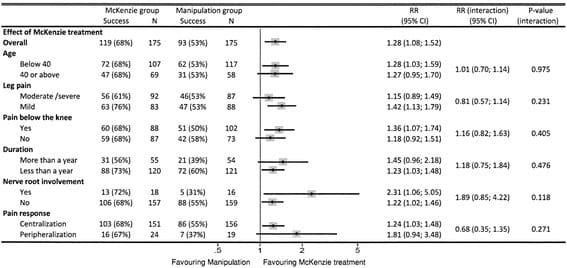
Figure 2 presents the modifying effect of a composite of the two predictors with a clinically important potential effect. If signs of nerve root involvement and peripheralization were present at baseline, the chance of success with MDT compared to SM appeared 8.5 times higher than for the subgroup with no centralization and nerve root involvement. The number of patients was very small and the differences were not statistically significant (P = 0.11).

None of the prognostic candidate variables explored in the supplementary analysis appeared to have any clinically important modifying effect (Additional file 1: Table S1).
The results from the sensitivity analysis using 30% relative improvement on RMDQ as definition of success were not markedly different from those presented above (Additional file 2: Table S2).
Discussion
To our knowledge, this is the first study trying to identify effect modifiers when two mobilizing strategies, i.e. MDT and SM, are compared in a sample of patients with as changeable condition characterized by centralization or peripheralization.
Our study found that none of the potential effect modifiers were able to statistically significantly increase the overall effect of MDT compared to that of SM. However, the between-group difference for two of the variables exceeded our clinically important success-rate of 15% in number of patients with successful outcome, so our study is likely to have missed a true effect and, in that sense, did not have a large enough sample size.
The most apparent finding is that in our small subgroup of patients with signs of nerve root involvement, the relative chance of success appeared 1.89 times (2.31/1.22) higher than in patients with no nerve root involvement when treated with MDT, compared to those treated with SM. The difference was in the expected direction.

Although not statistically significant in our small sample, the variable peripheralization exceeded our clinically important success-rate of 15%, but was found not to be in the expected direction. No previous studies have assessed the effect modification of centralization or peripheralization in patients with CLBP. The RCT by Long et al. [25,26] concluded that patients with directional preference, including centralization, fared better 2 weeks after baseline than patients with no directional preference when treated with MDT in comparison with strengthening training. However, the outcome among peripheralizers was not reported, so the poor outcome reported in patients with no directional preference might be related to the subgroup of patients who responded with no change in symptoms during initial examination and not to those that responded with peripheralization. An alternative explanation might be that the effect modifying impact of centralization or peripheralization on MDT is dependent on the control treatment. Our findings suggest that future studies in this area need to involve predictive value of peripheralization as well as centralization.
When a composite of the two most promising predictors, peripheralization and signs of nerve root involvement, were present at baseline, the relative chance of success with MDT compared to SM appeared 8.5 times higher than for the subgroup with no centralization and nerve root involvement. The number of patients was very small and the confidence interval was wide. Therefore only a preliminary conclusion about interaction can be drawn and it calls for a validation in future studies.
In our study, there appeared to be no characteristic by which SM had better results compared to MDT. Thus, we could not support the results of two studies with a similar design as ours (two arms, sample of patients with persistent LBP, and outcome reported in terms of reduction of disability at long term follow up) [27,29]. In those studies, Nyiendo et al. [29] found a modifying effect of leg pain below knee on treatment by SM compared to that of the general practitioner six months after baseline, and Koes et al. [27] found a modifying effect of age below 40 years and symptom duration more than a year on treatment by SM compared to that of physiotherapy 12 months after baseline. However, results from those, as well as other previous RCTs comprising patients with persistent LBP, have supported our findings regarding the lack of effect modification of age [27,29,31], sex [29,31], baseline disability [27,29,31], and duration of symptoms [31], on SM when measured on reduction of disability 6-12 months after randomization. So, although evidence is emerging in patients with acute LBP regarding subgroup characteristics predictive of better results from SM compared to other types of treatment [32], we are still in the dark with respect to patients with persistent LBP.
The usefulness of choosing a criterion for success by combining an improvement of at least 5 points or an absolute score below 5 points on RMDQ is debatable. A total of 22 patients were considered successful based on score below 5 at follow up without having an improvement of at least 5 points. We therefore performed a sensitivity analysis using a relative improvement of at least 30% as criterion of success as recommended by others [22] (see Additional file 2: Table S2). As a result, the percentage of patients with successful outcome in the MDT group remained the same whereas 4 more patients were defined as successes in the SM group. Overall the sensitivity analysis did not produce outcome results that were markedly different from those of the primary analysis and therefore only those have been discussed above.
Strengths and Limitations
This study used data from a RCT, whereas many others have used single arm designs not suitable for the purpose of evaluating treatment effect modification [33]. In accordance with the recommendations by the PROGRESS group [8] we prespecified the possible predictors and also the direction of the effect. Furthermore, we limited the number of predictors included in order to minimize the chance of spurious findings.
The main limitation in secondary studies to previously conducted RCTs is that they are powered to detect overall treatment effect rather that effect modification. In recognition of the post hoc nature of our analysis, reflected in wide confidence intervals, we must emphasize that our findings are exploratory and require formal testing in a larger sample size.

Conclusions
In all subgroups, the probability of success with MDT was superior to that of SM. Although not statistically significant, the presence of nerve root involvement and peripheralization appear promising effect modifiers in favour of MDT. These findings need testing in larger studies.
Acknowledgements
The authors thank Jan Nordsteen and Steen Olsen for clinical expert advice, and Mark Laslett for comments and language correction.
This study was in part supported by grants from The Danish Rheumatism Association, The Danish Physiotherapy Organization, The Danish Foundation for Chiropractic Research and Continuous Education, and The Danish Institute for Mechanical Diagnosis and Therapy. RC/The Parker Institute acknowledge the funding support from the Oak Foundation. The funds were independent of the management, analyses, and interpretation of the study.
Footnotes
Competing interests: The authors declare that they have no competing interests.
Authors’ contributions: All authors were involved in the data analysis and the writing process, and the requirements for authorship have been met. All analyses were conducted by TP, RC, and CJ. TP conceived and led the study and was responsible for writing the first draft of the paper, but the other authors have participated throughout the writing process and have read and approved the final version.
In conclusion, the above two articles were presented in order to evaluate the McKenzie method in the treatment of LBP in comparison to other types of treatment options. The first research study compared the McKenzie method with placebo therapy in patients with low back pain, however, the results of the study still need additional evaluations. In the second research study, no significant results could predict a different response in the use of the McKenzie method. Information referenced from the National Center for Biotechnology Information (NCBI). The scope of our information is limited to chiropractic as well as to spinal injuries and conditions. To discuss the subject matter, please feel free to ask Dr. Jimenez or contact us at 915-850-0900 .
Curated by Dr. Alex Jimenez
1
Waddell
G
. The Back Pain Revolution
. 2nd ed
. New York, NY
: Churchill Livingstone
; 2004
.
2
Murray
CJ
, Lopez
AD
. Measuring the global burden of disease
. N Engl J Med
. 2013
;369
:448
–457
.
Google Scholar
CrossRef
PubMed
3
Hoy
D
, Bain
C
, Williams
G
, et al.
. A systematic review of the global prevalence of low back pain
. Arthritis Rheum
. 2012
;64
:2028
–2037
.
Google Scholar
CrossRef
PubMed
4
van Tulder
MW
. Chapter 1: European guidelines
. Eur Spine J
. 2006
;15
:134
–135
.
Google Scholar
CrossRef
5
Costa Lda
C
, Maher
CG
, McAuley
JH
, et al.
. Prognosis for patients with chronic low back pain: inception cohort study
. BMJ
. 2009
;339
:b3829
.
Google Scholar
CrossRef
PubMed
6
da C Menezes Costa
, Maher
CG
, Hancock
MJ
, et al.
. The prognosis of acute and persistent low-back pain: a meta-analysis
. CMAJ
. 2012
;184
:E613
–E624
.
Google Scholar
CrossRef
PubMed
7
Henschke
N
, Maher
CG
, Refshauge
KM
, et al.
. Prognosis in patients with recent onset low back pain in Australian primary care: inception cohort study
. BMJ
. 2008
;337
:154
–157
.
Google Scholar
CrossRef
8
McKenzie
R
, May
S
. The Lumbar Spine: Mechanical Diagnosis & Therapy: Volume One
. 2nd ed
. Waikanae, New Zealand
: Spinal Publications
; 2003
.
9
Clare
HA
, Adams
R
, Maher
CG
. A systematic review of efficacy of McKenzie therapy for spinal pain
. Aust J Physiother
. 2004
;50
:209
–216
.
Google Scholar
CrossRef
PubMed
10
Machado
LA
, de Souza
MS
, Ferreira
PH
, Ferreira
ML
. The McKenzie method for low back pain: a systematic review of the literature with a meta-analysis approach
. Spine (Phila Pa 1976)
. 2006
;31
:254
–262
.
Google Scholar
CrossRef
PubMed
11
McKenzie
R
, May
S
. The Lumbar Spine: Mechanical Diagnosis & Therapy: Volume Two
. 2nd ed
. Waikanae, New Zealand
: Spinal Publications
; 2003
.
12
McKenzie
R
. Trate Nocê Mesmo a sua Coluna [Treat Your Own Back]
. Crichton, New Zealand
: Spinal Publications New Zealand Ltd
; 1998
.
13
Miller
ER
, Schenk
RJ
, Karnes
JL
, Rousselle
JG
. A comparison of the McKenzie approach to a specific spine stabilization program for chronic low back pain
. J Man Manip Ther
. 2005
;13
:103
–112
.
Google Scholar
CrossRef
14
Nwuga
G
, Nwuga
V
. Relative therapeutic efficacy of the Williams and McKenzie protocols in back pain management
. Physiother Theory Pract
. 1985
;1
:99
–105
.
Google Scholar
CrossRef
15
Petersen
T
, Larsen
K
, Jacobsen
S
. One-year follow-up comparison of the effectiveness of McKenzie treatment and strengthening training for patients with chronic low back pain: outcome and prognostic factors
. Spine (Phila Pa 1976)
. 2007
;32
:2948
–2956
.
Google Scholar
CrossRef
PubMed
16
Sakai
Y
, Matsuyama
Y
, Nakamura
H
, et al.
. The effect of muscle relaxant on the paraspinal muscle blood flow: a randomized controlled trial in patients with chronic low back pain
. Spine (Phila Pa 1976)
. 2008
;33
:581
–587
.
Google Scholar
CrossRef
PubMed
17
Udermann
BE
, Mayer
JM
, Donelson
RG
, et al.
. Combining lumbar extension training with McKenzie therapy: effects on pain, disability, and psychosocial functioning in chronic low back pain patients
. Gunders Lutheran Medical Journal
. 2004
;3
:7
–12
.
18
Airaksinen
O
, Brox
JI
, Cedraschi
C
, et al.
. Chapter 4: European guidelines for the management of chronic nonspecific low back pain
. Eur Spine J
. 2006
;15
:192
–300
.
Google Scholar
CrossRef
19
Kenney
LW
, Humphrey
RH
, Mahler
DA
. ACSM’s Guidelines for Exercise Testing and Prescription
. Baltimore, MD
: Williams & Wilkins
; 1995
.
20
Costa
LO
, Maher
CG
, Latimer
J
, et al.
. Clinimetric testing of three self-report outcome measures for low back pain patients in Brazil: which one is the best?
Spine (Phila Pa 1976)
. 2008
;33
:2459
–2463
.
Google Scholar
CrossRef
PubMed
21
Costa
LO
, Maher
CG
, Latimer
J
, et al.
. Psychometric characteristics of the Brazilian-Portuguese versions of the Functional Rating Index and the Roland-Morris Disability Questionnaire
. Spine (Phila Pa 1976)
. 2007
;32
:1902
–1907
.
Google Scholar
CrossRef
PubMed
22
Nusbaum
L
, Natour
J
, Ferraz
MB
, Goldenberg
J
. Translation, adaptation and validation of the Roland-Morris questionnaire: Brazil Roland-Morris
. Braz J Med Biol Res
. 2001
;34
:203
–210
.
Google Scholar
CrossRef
PubMed
23
de Souza
FS
, Marinho Cda
S
, Siqueira
FB
, et al.
. Psychometric testing confirms that the Brazilian-Portuguese adaptations, the original versions of the Fear-Avoidance Beliefs Questionnaire, and the Tampa Scale of Kinesiophobia have similar measurement properties
. Spine (Phila Pa 1976)
. 2008
;33
:1028
–1033
.
Google Scholar
CrossRef
PubMed
24
Devilly
GJ
, Borkovec
TD
. Psychometric properties of the credibility/expectancy questionnaire
. J Behav Ther Exp Psychiatry
. 2000
;31
:73
–86
.
Google Scholar
CrossRef
PubMed
25
Chatman
AB
, Hyams
SP
, Neel
JM
, et al.
. The Patient-Specific Functional Scale: measurement properties in patients with knee dysfunction
. Phys Ther
. 1997
;77
:820
–829
.
Google Scholar
PubMed
26
Pengel
LH
, Refshauge
KM
, Maher
CG
. Responsiveness of pain, disability, and physical impairment outcomes in patients with low back pain
. Spine (Phila Pa 1976)
. 2004
;29
:879
–883
.
Google Scholar
CrossRef
PubMed
27
Garcia
AN
, Costa
LCM
, da Silva
TM
, et al.
. Effectiveness of Back School versus McKenzie exercises in patients with chronic nonspecific low back pain: a randomized controlled trial
. Phys Ther
. 2013
;93
:729
–747
.
Google Scholar
CrossRef
PubMed
28
Manchester
MR
, Glasgow
GW
, York
JKM
, et al.
. The Back Book: Clinical Guidelines for the Management of Acute Low Back Pain
. London, United Kingdom
: Stationery Office Books
; 2002
:1
–28
.
29
Delitto
A
, George
SZ
, Van Dillen
LR
, et al.
. Low back pain
. J Orthop Sports Phys Ther
. 2012
;42
:A1
–A57
.
Google Scholar
CrossRef
PubMed
30
van Tulder
M
, Becker
A
, Bekkering
T
, et al.
. Chapter 3: European guidelines for the management of acute nonspecific low back pain in primary care
. Eur Spine J
. 2006
;15
:169
–191
.
Google Scholar
CrossRef
31
Costa
LO
, Maher
CG
, Latimer
J
, et al.
. Motor control exercise for chronic low back pain: a randomized placebo-controlled trial
. Phys Ther
. 2009
;89
:1275
–1286
.
Google Scholar
CrossRef
PubMed
32
Balthazard
P
, de Goumoens
P
, Rivier
G
, et al.
. Manual therapy followed by specific active exercises versus a placebo followed by specific active exercises on the improvement of functional disability in patients with chronic non specific low back pain: a randomized controlled trial
. BMC Musculoskelet Disord
. 2012
;13
:162
.
Google Scholar
CrossRef
PubMed
33
Kumar
SP
. Efficacy of segmental stabilization exercise for lumbar segmental instability in patients with mechanical low back pain: a randomized placebo controlled crossover study
. N Am J Med Sci
. 2012
;3
:456
–461
.
34
Ebadi
S
, Ansari
NN
, Naghdi
S
, et al.
. The effect of continuous ultrasound on chronic non-specific low back pain: a single blind placebo-controlled randomized trial
. BMC Musculoskelet Disord
. 2012
;13
:192
.
Google Scholar
CrossRef
PubMed
35
Williams
CM
, Latimer
J
, Maher
CG
, et al.
. PACE—the first placebo controlled trial of paracetamol for acute low back pain: design of a randomised controlled trial
. BMC Musculoskelet Disord
. 2010
;11
:169
.
Google Scholar
CrossRef
PubMed
36
Hollis
S
, Campbell
F
. What is meant by intention to treat analysis? Survey of published randomised controlled trials
. BMJ
. 1999
;319
:670
–674
.
Google Scholar
CrossRef
PubMed
37
Twisk
JWR
. Applied Longitudinal Data Analysis for Epidemiology: A Practical Guide
. New York, NY
: Cambridge University Press
; 2003
.
38
Hancock
MJ
, Maher
CG
, Latimer
J
, et al.
. Assessment of diclofenac or spinal manipulative therapy, or both, in addition to recommended first-line treatment for acute low back pain: a randomised controlled trial
. Lancet
. 2007
;370
:1638
–1643
.
Google Scholar
CrossRef
PubMed
39
Pengel
LH
, Refshauge
KM
, Maher
CG
, et al.
. Physiotherapist-directed exercise, advice, or both for subacute low back pain: a randomized trial
. Ann Intern Med
. 2007
;146
:787
–796
.
Google Scholar
CrossRef
PubMed
40
Costa Lda
C
, Koes
BW
, Pransky
G
, et al.
. Primary care research priorities in low back pain: an update
. Spine (Phila Pa 1976)
. 2013
;38
:148
–156
.
Google Scholar
CrossRef
PubMed
1. Chou R, Qaseem A, Snow V, Casey D, Cross JT, Jr, Shekelle P, et al. Diagnosis and treatment of low back pain: a joint clinical practice guideline from the American College of Physicians and the American Pain Society. Ann Intern Med. 2007;147(7):478–91. doi: 10.7326/0003-4819-147-7-200710020-00006. [PubMed] [Cross Ref]
2. NHS Early management of persistent non-specific low back pain. NICE Clinical Guideline. 2009;88:1–30.
3. Cherkin DC, Battie MC, Deyo RA, Street JH, Barlow W. A comparison of physical therapy, chiropractic manipulation, and provision of an educational booklet for the treatment of patients with low back pain. N Engl J Med. 1998;339(15):1021–9. doi: 10.1056/NEJM199810083391502. [PubMed] [Cross Ref]
4. Paatelma M, Kilpikoski S, Simonen R, Heinonen A, Alen M, Videman T. Orthopaedic manual therapy, McKenzie method or advice only for low back pain in working adults. A randomized controlled trial with 1 year follow-up. J Rehabil Med. 2008;40(10):858–63. doi: 10.2340/16501977-0262. [PubMed] [Cross Ref]
5. Foster NE, Dziedzic KS, van Der Windt DA, Fritz JM, Hay EM. Research priorities for non-pharmacological therapies for common musculoskeletal problems: nationally and internationally agreed recommendations. BMC Musculoskelet Disord. 2009;10:3. doi: 10.1186/1471-2474-10-3. [PMC free article] [PubMed] [Cross Ref]
6. Kamper SJ, Maher CG, Hancock MJ, Koes BW, Croft PR, Hay E. Treatment-based subgroups of low back pain: a guide to appraisal of research studies and a summary of current evidence. Best Pract Res Clin Rheumatol. 2010;24(2):181–91. doi: 10.1016/j.berh.2009.11.003. [PubMed] [Cross Ref]
7. Airaksinen O, Brox JI, Cedraschi C, Hildebrandt J, Klaber-Moffett J, Kovacs F, et al. Chapter 4. European guidelines for the management of chronic nonspecific low back pain. Eur Spine J. 2006;15(Suppl 2):S192–300. doi: 10.1007/s00586-006-1072-1. [PMC free article] [PubMed] [Cross Ref]
8. Hingorani AD, Windt DA, Riley RD, Abrams K, Moons KG, Steyerberg EW, et al. Prognosis research strategy (PROGRESS) 4: Stratified medicine research. BMJ. 2013;346:e5793. doi: 10.1136/bmj.e5793. [PMC free article] [PubMed] [Cross Ref]
9. Fersum KV, Dankaerts W, O’Sullivan PB, Maes J, Skouen JS, Bjordal JM, et al. Integration of sub-classification strategies in RCTs evaluating manual therapy treatment and exercise therapy for non-specific chronic low back pain (NSCLBP): a systematic review. Br J Sports Med. 2010;44(14):1054–62. doi: 10.1136/bjsm.2009.063289. [PubMed] [Cross Ref]
10. Erhard RE, Delitto A, Cibulka MT. Relative effectiveness of an extension program and a combined program of manipulation and flexion and extension exercises in patients with acute low back syndrome. Phys Ther. 1994;74(12):1093–100. [PubMed]
11. Schenk RJ, Josefczyk C, Kopf A. A randomized trial comparing interventions in patients with lumbar posterior derangement. J Man Manipul Ther. 2003;11(2):95–102. doi: 10.1179/106698103790826455. [Cross Ref]
12. Kilpikoski S, Alen M, Paatelma M, Simonen R, Heinonen A, Videman T. Outcome comparison among working adults with centralizing low back pain: Secondary analysis of a randomized controlled trial with 1-year follow-up. Adv Physiol Educ. 2009;11:210–7. doi: 10.3109/14038190902963087. [Cross Ref]
13. Petersen T, Larsen K, Nordsteen J, Olsen S, Fournier G, Jacobsen S. The McKenzie method compared with manipulation when used adjunctive to information and advice in low back pain patients presenting with centralization or peripheralization. A randomized controlled trial. Spine (Phila Pa 1976) 2011;36(24):1999–2010. doi: 10.1097/BRS.0b013e318201ee8e. [PubMed] [Cross Ref]
14. Petersen T, Olsen S, Laslett M, Thorsen H, Manniche C, Ekdahl C, et al. Inter-tester reliability of a new diagnostic classification system for patients with non-specific low back pain. Aust J Physiother. 2004;50:85–94. doi: 10.1016/S0004-9514(14)60100-8. [PubMed] [Cross Ref]
15. Waddell G, McCulloch JA, Kummel E, Venner RM. Nonorganic physical signs in low-back pain. Spine. 1980;5(2):117–25. doi: 10.1097/00007632-198003000-00005. [PubMed] [Cross Ref]
16. Manniche C, Asmussen K, Lauritsen B, Vinterberg H, Kreiner S, Jordan A. Low Back Pain Rating scale: validation of a tool for assessment of low back pain. Pain. 1994;57(3):317–26. doi: 10.1016/0304-3959(94)90007-8. [PubMed] [Cross Ref]
17. McKenzie RA. Treat your own back. Waikanae: Spinal Publications New Zealand Ltd; 1997.
18. Burton AK, Waddell G, Tillotson KM, Summerton N. Information and advice to patients with back pain can have a positive effect. A randomized controlled trial of a novel educational booklet in primary care. Spine. 1999;24(23):2484–91. doi: 10.1097/00007632-199912010-00010. [PubMed] [Cross Ref]
19. Patrick DL, Deyo RA, Atlas SJ, Singer DE, Chapin A, Keller RB. Assessing health-related quality of life in patients with sciatica. Spine. 1995;20(17):1899–908. doi: 10.1097/00007632-199509000-00011. [PubMed] [Cross Ref]
20. Albert H, Jensen AM, Dahl D, Rasmussen MN. Criteria validation of the Roland Morris questionnaire. A Danish translation of the international scale for the assessment of functional level in patients with low back pain and sciatica [Kriterievalidering af Roland Morris Spørgeskemaet – Et oversat internationalt skema til vurdering af ændringer i funktionsniveau hos patienter med lændesmerter og ischias] Ugeskr Laeger. 2003;165(18):1875–80. [PubMed]
21. Bombardier C, Hayden J, Beaton DE. Minimal clinically important difference. Low back pain: outcome measures. J Rheumatol. 2001;28(2):431–8. [PubMed]
22. Ostelo RW, Deyo RA, Stratford P, Waddell G, Croft P, Von KM, et al. Interpreting change scores for pain and functional status in low back pain: towards international consensus regarding minimal important change. Spine. 2008;33(1):90–4. doi: 10.1097/BRS.0b013e31815e3a10. [PubMed] [Cross Ref]
23. Moons KG, Royston P, Vergouwe Y, Grobbee DE, Altman DG. Prognosis and prognostic research: what, why, and how? BMJ. 2009;338:1317–20. doi: 10.1136/bmj.b1317. [PubMed] [Cross Ref]
24. Sun X, Briel M, Walter SD, Guyatt GH. Is a subgroup effect believable? Updating criteria to evaluate the credibility of subgroup analyses. BMJ. 2010;340:c117. doi: 10.1136/bmj.c117. [PubMed] [Cross Ref]
25. Long A, Donelson R, Fung T. Does it matter which exercise? A randomized control trial of exercise for low back pain. Spine. 2004;29(23):2593–602. doi: 10.1097/01.brs.0000146464.23007.2a. [PubMed] [Cross Ref]
26. Long A, May S, Fung T. The comparative prognostic value of directional preference and centralization: a useful tool for front-line clinicians? J Man Manip Ther. 2008;16(4):248–54. doi: 10.1179/106698108790818332. [PMC free article] [PubMed] [Cross Ref]
27. Koes BW, Bouter LM, van Mameren H, Essers AH, Verstegen GJ, Hofhuizen DM, et al. A randomized clinical trial of manual therapy and physiotherapy for persistent back and neck complaints: subgroup analysis and relationship between outcome measures. J Manipulative Physiol Ther. 1993;16(4):211–9. [PubMed]
28. Leboeuf-Yde C, Gronstvedt A, Borge JA, Lothe J, Magnesen E, Nilsson O, et al. The nordic back pain subpopulation program: demographic and clinical predictors for outcome in patients receiving chiropractic treatment for persistent low”back pain. J Manipulative Physiol Ther. 2004;27(8):493–502. doi: 10.1016/j.jmpt.2004.08.001. [PubMed] [Cross Ref]
29. Nyiendo J, Haas M, Goldberg B, Sexton G. Pain, disability, and satisfaction outcomes and predictors of outcomes: a practice-based study of chronic low back pain patients attending primary care and chiropractic physicians. J Manipulative Physiol Ther. 2001;24(7):433–9. doi: 10.1016/S0161-4754(01)77689-0. [PubMed] [Cross Ref]
30. Foster NE, Hill JC, Hay EM. Subgrouping patients with low back pain in primary care: are we getting any better at it? Man Ther. 2011;16(1):3–8. doi: 10.1016/j.math.2010.05.013. [PubMed] [Cross Ref]
31. Underwood MR, Morton V, Farrin A. Do baseline characteristics predict response to treatment for low back pain? Secondary analysis of the UK BEAM dataset. Rheumatology (Oxford) 2007;46(8):1297–302. doi: 10.1093/rheumatology/kem113. [PubMed] [Cross Ref]
32. Slater SL, Ford JJ, Richards MC, Taylor NF, Surkitt LD, Hahne AJ. The effectiveness of sub-group specific manual therapy for low back pain: a systematic review. Man Ther. 2012;17(3):201–12. doi: 10.1016/j.math.2012.01.006. [PubMed] [Cross Ref]
33. Stanton TR, Hancock MJ, Maher CG, Koes BW. Critical appraisal of clinical prediction rules that aim to optimize treatment selection for musculoskeletal conditions. Phys Ther. 2010;90(6):843–54. doi: 10.2522/ptj.20090233. [PubMed] [Cross Ref]

Additional Topics: Sciatica
Sciatica is referred to as a collection of symptoms rather than a single type of injury or condition. The symptoms are characterized as radiating pain, numbness and tingling sensations from the sciatic nerve in the lower back, down the buttocks and thighs and through one or both legs and into the feet. Sciatica is commonly the result of irritation, inflammation or compression of the largest nerve in the human body, generally due to a herniated disc or bone spur.

IMPORTANT TOPIC: EXTRA EXTRA: Treating Sciatica Pain
Post Disclaimer
Professional Scope of Practice *
The information on this blog site is not intended to replace a one-on-one relationship with a qualified healthcare professional or licensed physician and is not medical advice. We encourage you to make healthcare decisions based on your research and partnership with a qualified healthcare professional.
Blog Information & Scope Discussions
Welcome to El Paso's Premier Wellness and Injury Care Clinic & Wellness Blog, where Dr. Alex Jimenez, DC, FNP-C, a board-certified Family Practice Nurse Practitioner (FNP-BC) and Chiropractor (DC), presents insights on how our team is dedicated to holistic healing and personalized care. Our practice aligns with evidence-based treatment protocols inspired by integrative medicine principles, similar to those found on this site and our family practice-based chiromed.com site, focusing on restoring health naturally for patients of all ages.
Our areas of chiropractic practice include Wellness & Nutrition, Chronic Pain, Personal Injury, Auto Accident Care, Work Injuries, Back Injury, Low Back Pain, Neck Pain, Migraine Headaches, Sports Injuries, Severe Sciatica, Scoliosis, Complex Herniated Discs, Fibromyalgia, Chronic Pain, Complex Injuries, Stress Management, Functional Medicine Treatments, and in-scope care protocols.
Our information scope is limited to chiropractic, musculoskeletal, physical medicine, wellness, contributing etiological viscerosomatic disturbances within clinical presentations, associated somato-visceral reflex clinical dynamics, subluxation complexes, sensitive health issues, and functional medicine articles, topics, and discussions.
We provide and present clinical collaboration with specialists from various disciplines. Each specialist is governed by their professional scope of practice and their jurisdiction of licensure. We use functional health & wellness protocols to treat and support care for the injuries or disorders of the musculoskeletal system.
Our videos, posts, topics, subjects, and insights cover clinical matters and issues that relate to and directly or indirectly support our clinical scope of practice.*
Our office has made a reasonable effort to provide supportive citations and has identified relevant research studies that support our posts. We provide copies of supporting research studies available to regulatory boards and the public upon request.
We understand that we cover matters that require an additional explanation of how they may assist in a particular care plan or treatment protocol; therefore, to discuss the subject matter above further, please feel free to ask Dr. Alex Jimenez, DC, APRN, FNP-BC, or contact us at 915-850-0900.
We are here to help you and your family.
Blessings
Dr. Alex Jimenez DC, MSACP, APRN, FNP-BC*, CCST, IFMCP, CFMP, ATN
email: coach@elpasofunctionalmedicine.com
Licensed as a Doctor of Chiropractic (DC) in Texas & New Mexico*
Texas DC License # TX5807
New Mexico DC License # NM-DC2182
Licensed as a Registered Nurse (RN*) in Texas & Multistate
Texas RN License # 1191402
ANCC FNP-BC: Board Certified Nurse Practitioner*
Compact Status: Multi-State License: Authorized to Practice in 40 States*
Graduate with Honors: ICHS: MSN-FNP (Family Nurse Practitioner Program)
Degree Granted. Master's in Family Practice MSN Diploma (Cum Laude)
Dr. Alex Jimenez, DC, APRN, FNP-BC*, CFMP, IFMCP, ATN, CCST
My Digital Business Card


